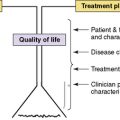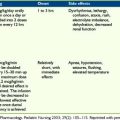38 Inherited Life-Threatening Illnesses
Inherited medical conditions are often amenable to medical management and frequently do not significantly affect life expectancy. However, such conditions can also be life-threatening and lead to early death. Inherited conditions and their associated cultural constructs often impact patients, families, and medical providers in ways that should be considered part of palliative care. Caring for a child with a life-threatening illness secondary to an inherited condition poses a unique set of challenges best addressed by an interdisciplinary approach. Though a complete review of all inherited life-threatening conditions is beyond the scope of this chapter, the table lists some common examples (Table 38-1).
TABLE 38-1 Life-Threatening Inherited Conditions
| Examples, inheritance patterns, and clinical descriptions of several types of life-threatening inherited conditions. The listed categories overlap considerably but are a useful framework for thinking about inherited conditions. |
| Condition type and examples | Inheritance | Description and clinical course |
|---|---|---|
| Metabolic Disease | ||
| MELAS | Mitochondrial | Characterized by mitochondrial encephalomyopathy, lactic acidosis, and strokelike episodes that typically present in mid- to late childhood. Early development is often normal. Seizures and hearing loss are common. |
| Maple syrup urine disease (MSUD) | Autosomal recessive | Caused by branched-chain alpha-ketoacid dehydrogenase complex deficiency that, without treatment, results in poor feeding, irritability, coma, and central respiratory failure. Manifestations vary with level of enzyme activity. |
| Multiple Malformations | ||
| Smith-Lemli-Opitz syndrome | Autosomal recessive | Individuals may have multiple anomalies of cleft palate, heart defect, hypospadias, abnormal genitalia, growth retardation. The condition results from mutations in the gene encoding 7-dehydrocholesterol reductase, an enzyme involved in cholesterol metabolism. |
| Noonan syndrome | Autosomal dominant | Individuals may have congenital heart disease, coagulation abnormalities, cryptorchidism, chest deformities, and developmental delay. There are several genes known to cause the condition; however, a genetic change is not detected in all individuals with a clinical diagnosis. |
| Chromosomal | ||
| Trisomy 13 | Chromosomal | Often presents prenatally or at birth with multiple anomalies, including congenital heart disease and craniofacial malformations. Infants usually die in the first year of life from central apnea, but the clinical course is variable. |
| Williams syndrome | Chromosomal | Individuals often have cardiovascular disease, endocrine abnormalities, connective tissue differences, and mild mental retardation. A contiguous chromosomal deletion involving 7q11.2 is present in 99% of cases. |
| Neuromuscular Disease | ||
| Duchenne muscular dystrophy (DMD) | X-linked | Affected males often present with delayed milestones, and progressive muscle weakness and atrophy cause wheelchair dependency by age 13 with early death from respiratory and cardiac failure. DMD represents the severe end of the spectrum of dystrophinopathies. |
| Neurodegenerative Disease | ||
| Adrenoleukodystrophy | X-linked | The childhood cerebral form typically first presents with attention deficit disorder and progresses to cognitive, motor, vision, and hearing impairment, to complete disability within a few years. Widely variable expression even among individuals in the same family. |
| Storage Disease | ||
| Hunter syndrome | X-linked | A lysosomal storage disease that results in progressive excess storage of glycosaminoglycans. Symptoms include hepatosplenomegaly, CNS involvement, coarse facial features, and joint contractures. Respiratory and/or cardiac diseases are the major causes of morbidity and mortality. Onset and symptoms vary widely. |
| Pompe disease | Autosomal recessive | A glycogen storage disease that often presents with feeding difficulty, muscle weakness, hypotonia, and cardiomyopathy in the severe infantile-onset form. Without enzyme replacement therapy (ERT), infants often die in the first year of life. |
| Skeletal Dysplasia | ||
| Campomelic dysplasia | Autosomal dominant | Most individuals die during the neonatal period from respiratory insufficiency. Symptoms include severe laryngotracheomalacia, Pierre Robin sequence, ambiguous genitalia, club feet, bowed limbs, dislocated hips, and short stature. Cervical spine abnormalities, scoliosis, and kyphosis are common. Many females are found to be 46, XY. |
Specific Care Challenges
The stigma, recurrence risk, and isolation that inherited life-threatening illnesses impart all affect attitudes and goals about the treatment plan.1 Understanding the specific challenges faced by families and children affected by inherited life-threatening illnesses allows providers to respond to an individual family’s needs when broaching the subject of palliative care.
Stigma, guilt, and shame
The very concept of having passed on a life-threatening condition is a staggering source of guilt for many parents and grandparents. In conditions inherited through a single parent, this guilt can be unevenly distributed.2 Feelings of guilt in a parent may influence decisions regarding both care meant to prolong life and care meant to improve quality of life. An overwhelming sense of responsibility may prevent some parents from asking for assistance. Although parental guilt is a normal response to having a child with an inherited illness, medical providers should be alert for signs of caregiver fatigue or family stress related to these feelings. Genetic counselors are specially trained to work with families around the time of initial diagnosis. The responses of family members often stem from a desire to find underlying meaning for the birth of a child with a genetic condition. Some parents may believe that a past action or inaction caused their child to have a birth defect or an inherited condition.3 Some parents are ashamed for having a child who does not fit the ideals they had prior to, or during, pregnancy.4 Some children or families who have particular difficulty adjusting to a genetic diagnosis may benefit from psychiatry or psychology consultations to discuss these feelings in greater detail.
Even aside from the issue of parental responsibility, genetic conditions are further stigmatizing society’s tendency to view a genetic difference as an inherent personal flaw. Medical staff should do all possible not to propagate this viewpoint. In fact, assessing the families’ experiences and listening to responses during initial consultations may give clues regarding feelings of guilt or shame. Patients or families experiencing shame will, at times, withdraw from the situation. Those experiencing an internal sense of responsibility or guilt may blame themselves, rationalize, or intellectualize the situation. Lack of control can be particularly painful for parents experiencing this unrealistic sense of responsibility.4 Actively engaging in medical decision making may allow families to feel that they have regained some control.
Language choice
In this increasingly protocol-driven medical environment, providers are often tempted to rely on shorthand terms such as Downs baby to refer to an infant with Down syndrome or CF-er to refer to a child with cystic fibrosis. By doing so, however, they unintentionally marginalize the affected child and suggest that he or she is defined entirely by the disease. Providers should be sensitive to the use of person-first language and current terminology. Providers may invite the family to provide their preferred terminology. For example, a family may express concern regarding the use of mental retardation and prefer cognitive impairment or static encephalopathy. Use of potentially offensive terminology may impede the relationship with the family and prevent open discussion of sensitive issues such as prognosis and end-of-life care. Conversely, choosing language that personalizes the child can set the tone for a holistic approach to medical care giving. Language implying that the medical team sees the child as a whole person allows patients and families to share their goals with the care team.5
Role of Diagnostic Workup
Such a specialist is also best able to address the implications of a genetic diagnosis for other family members. Although taking the focus from a patient with a life-threatening illness may seem distasteful, it is essential to family-centered care to consider other family members in the workup and treatment for inherited life-threatening conditions.6 For some children and families, finding a diagnosis that will facilitate treatment and family planning for relatives is seen as a legacy left by the patient.
Uncertainty, prognosis, and treatment
Delineation of the molecular basis of inherited disease has ushered in novel therapies, some available only on a research basis. Consulted specialists may know of specific trials for which an affected patient would be eligible. Clinical trials can also be sought through the government-sanctioned website www.clinicaltrials.gov. There may already be some evidence of medical benefit, or lack thereof, of the experimental treatment in question. In other trials, the benefit is less clear. Most families are interested in learning of open trials; some are interested in enrolling and may actually raise the subject. The care team should recognize that participation in these trials may be of greater significance to a patient or family than as last-ditch attempt at treatment; engaging in research-based activities may fulfill the deeper obligation of doing everything to fight an illness. Furthermore, families may be interested in involvement of clinical research studies solely to benefit other families in the future and have comfort in knowing they may be contributing to advancing knowledge about the condition.
Introducing the Topic of Palliative Care
The concept of palliative care should be introduced at the outset of treatment for any life-threatening condition. Incorporating this topic into the treatment plan routinely will over time dispel the stereotypical thinking that palliative care is intended for only those children for whom all other treatment options have been exhausted or dismissed. An investigation of a series of complaints7 from young adults and family members affected by CF revealed they had been taken aback by a palliative care survey. Most of the complaints centered on the idea that any discussion of palliative care was not appropriate given the perceived good health of the affected individual. These reactions, which were not necessarily inappropriate, indicate that the topic was a relatively unfamiliar one to the complainants.
1 Knebel A., Hudgings C. End-of-life issues in genetic disorders: summary of workshop held at the National Institutes of Health on September 26, 2001. Genet Med. 2002;4:373-378.
2 James C., Hadley D., Holtzman N., et al. How does the mode of inheritance of a genetic condition influence families? A study of guilt, blame, stigma, and understanding of inheritance and reproductive risks in families with X-linked and autosomal recessive diseases. Genet Med. 2006;8:234-242.
3 Murray R.R.Jr. Psychosocial aspects of genetic counseling. Soc Work Health Care. 1976;2:13-23.
4 Kessler S., Kessler H., Ward P. Psychological aspects of genetic counseling. III. Management of guilt and shame. Am J Med Genet. 1984;17:673-697.
5 Hodgson J., Hughs E., Lambert C. “SLANG”—Sensitive Language and the New Genetics: an exploratory study. J Genet Couns. 2005;14:415-421.
6 Quillinn J., Bodurtha J., Smith T. Genetics assessment at the end of life: suggestions for implementation in clinic and future research. J Palliat Med. 2008;11:451-458.
7 Braithwait M., Philip J., Finlayson F., et al. Adverse events arising from a palliative care survey. Palliat Med. 2009;23:665-669.





